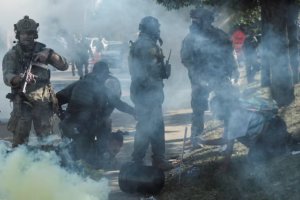The United States government shutdown entered its sixth day on Monday, paralyzed federal operations, and heightened a dangerous political game of blame, with the White House threatening mass layoffs of federal workers if the impasse continues.
The political standoff is centered on a fundamental disagreement over priorities. Senate Democrats are demanding a long-term extension of Affordable Care Act (ACA) subsidies to prevent an increase in health insurance premiums for millions of Americans. Republicans, who control the House, have passed a short-term spending bill that does not include this measure, leading to a legislative standoff.
The Senate, held by Republicans, was set to vote on Monday on dueling proposals, but neither the Republican stopgap nor the Democratic alternative was expected to get the 60 votes needed to advance, foretelling no fast escape from the deadlock.
Hardball Tactics and Mounting Threats
The political rhetoric escalated over the weekend. President Donald Trump, asked when federal employees would be laid off, replied, “It’s happening right now,” but did not elaborate. The White House has indicated that thousands of employees could be furloughed if the shutdown lasts.
Adding further to the tension, Trump’s budget director, Russell Vought, has frozen a total of roughly $28 billion in congressionally appropriated infrastructure funds for New York, California, and Illinois—Democratic bastions with vocal critics of the president. Democrats have called the move punitive and political.
Pouring more gasoline on the flames, Trump and his Republican allies have taunted Democrats on social media with deepfake videos employing Mexican stereotypes, which Vice President JD Vance later dismissed as a “joke.”
Democratic lawmakers have been unbending in the face of these tactics. “What we’ve seen is negotiation through deepfake videos, the House delaying votes and, of course, President Trump spending yesterday on the golf course. That’s not responsible behavior,” House Democratic leader Hakeem Jeffries remarked on NBC’s “Meet the Press.”
The Key Sticking Points
The shutdown, now tied for the fourth-longest in U.S. history, is gridlocked over two principal Democratic demands:
Healthcare Subsidies: Democrats are insisting on locking in federal ACA subsidies before open enrollment begins on November 1. “We need to get this done by November 1,” Democratic Senator Ruben Gallego cautioned. “If we don’t, it will mean higher healthcare costs for enrollees and maybe no insurance coverage at all.”

Funding Guarantee: Mistrustful of the administration, Democrats are calling for legal assurances that the White House cannot unilaterally withhold funds already approved by Congress. “If we reach an agreement on a [stopgap bill] and nothing more, they’re telling us: ‘We don’t plan to abide by it,'” Democratic Senator Adam Schiff said. “I’m not willing to accept a commitment that they’re not going to renege on any agreement we make.”
Republican leaders, who need a minimum of eight Democrats to cross the aisle in order to pass their bill, have characterized the fix as simple. “All we have to do is get five more Democrats to vote ‘yes,’ the government opens up, and then we can start talking about all these other things,” Senate Majority Leader John Thune said.
Democratic Senate Leader Chuck Schumer, however, fired back that Republican negotiators so far have “offered nothing,” and that a breakthrough would require an upper-level agreement among leaders of both parties and the White House.
The standoff has trapped about $1.7 trillion in discretionary federal funding, impacting a wide range of government services and agencies. With trust collapsing and hardline tactics escalating, a quick resolution appears increasingly unlikely, leaving federal workers and essential government functions in a state of prolonged limbo.




